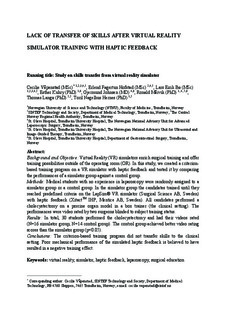| dc.contributor.author | Våpenstad, Cecilie | |
| dc.contributor.author | Hofstad, Erlend Fagertun | |
| dc.contributor.author | Bø, Lars Eirik | |
| dc.contributor.author | Kuhry, Esther | |
| dc.contributor.author | Johnsen, Gjermund | |
| dc.contributor.author | Mårvik, Ronald | |
| dc.contributor.author | Langø, Thomas | |
| dc.contributor.author | Hernes, Toril A. Nagelhus | |
| dc.date.accessioned | 2017-05-18T07:45:46Z | |
| dc.date.available | 2017-05-18T07:45:46Z | |
| dc.date.created | 2017-05-15T14:06:42Z | |
| dc.date.issued | 2017 | |
| dc.identifier.issn | 1364-5706 | |
| dc.identifier.uri | http://hdl.handle.net/11250/2442706 | |
| dc.description.abstract | Background and objective: Virtual reality (VR) simulators enrich surgical training and offer training possibilities outside of the operating room (OR). In this study, we created a criterion-based training program on a VR simulator with haptic feedback and tested it by comparing the performances of a simulator group against a control group.
Material and methods: Medical students with no experience in laparoscopy were randomly assigned to a simulator group or a control group. In the simulator group, the candidates trained until they reached predefined criteria on the LapSim® VR simulator (Surgical Science AB, Göteborg, Sweden) with haptic feedback (XitactTM IHP, Mentice AB, Göteborg, Sweden). All candidates performed a cholecystectomy on a porcine organ model in a box trainer (the clinical setting). The performances were video rated by two surgeons blinded to subject training status.
Results: In total, 30 students performed the cholecystectomy and had their videos rated (N = 16 simulator group, N = 14 control group). The control group achieved better video rating scores than the simulator group (p < .05).
Conclusions: The criterion-based training program did not transfer skills to the clinical setting. Poor mechanical performance of the simulated haptic feedback is believed to have resulted in a negative training effect. | nb_NO |
| dc.language.iso | eng | nb_NO |
| dc.publisher | Taylor & Francis | nb_NO |
| dc.title | Lack of transfer of skills after virtual reality simulator training with haptic feedback | nb_NO |
| dc.type | Journal article | nb_NO |
| dc.type | Peer reviewed | nb_NO |
| dc.description.version | acceptedVersion | |
| dc.source.journal | MITAT. Minimally invasive therapy & allied technologies | nb_NO |
| dc.identifier.doi | 10.1080/13645706.2017.1319866 | |
| dc.identifier.cristin | 1470284 | |
| dc.description.localcode | This is the authors' accepted and refereed manuscript to the article. Locked until 09 May 2018 due to copyright restrictions | nb_NO |
| cristin.unitcode | 194,65,25,0 | |
| cristin.unitcode | 194,65,15,0 | |
| cristin.unitname | Institutt for sirkulasjon og bildediagnostikk | |
| cristin.unitname | Institutt for kreftforskning og molekylær medisin | |
| cristin.ispublished | true | |
| cristin.fulltext | postprint | |
| cristin.qualitycode | 1 | |
